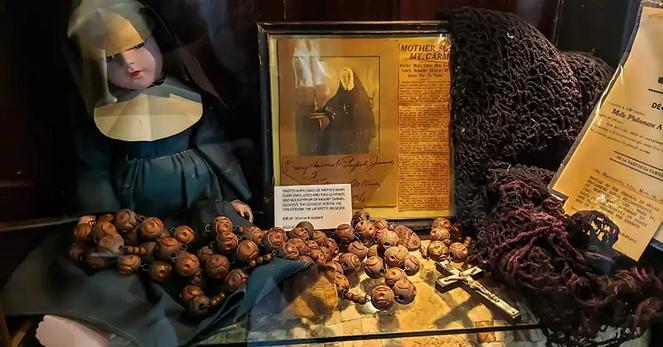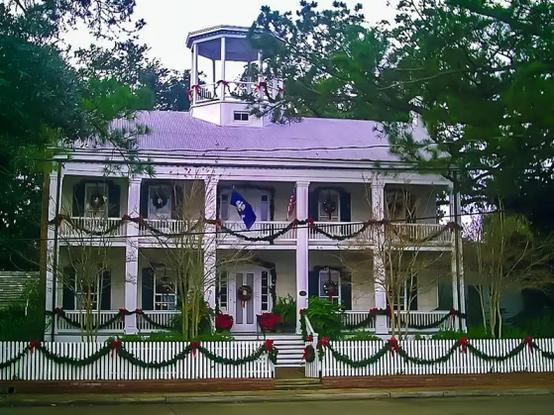Historic Home of 1800s Governor in Lafayette, LA: Alexandre Mouton
Alexandre Mouton was a statesman and governor in Louisiana. His Lafayette home, known now as the Lafayette Museum as well as the Alexandre Mouton House, has been restored to its 1848 grandeur. This makes it a key Lafayette attraction for visitors.
Mardi Gras costumes displayed at the Lafayette Museum in Louisiana. Photo by Linda Aksomitis.Fast Fact: The costumes in the Mardi Gras room are elaborate creations from various local krewes, spanning eras from the 1960s to the present.
Linda’s Pick of the Exhibits
My favorite exhibit is typically one that’s unique and expands my knowledge of a place’s history — in the Mouton House, that was the Nun’s Room. It helped remind me of the diverse cultural and religious influences throughout Lafayette’s history. While Jean Mouton, who built the original parts of the Mouton house, was Acadian, Lafayette had many other influences.
Display of doll dressed as a nun and photograph with clippings about Mother Mary Clare (1875 – 1935). Photo by Linda Aksomitis.The room honors the Mt. Carmel sisters who lived across the street for over 100 years. The Carmelite order traces back to Mount Carmel in northwestern Israel about 1155. Their rule was written between 1206 and 1214 by St. Albert.
Fast Fact: When a daughter entered the convent early in the 20th century, her hair was cut and customarily sent to New Orleans to be tatted into a wreath. Wreaths were often displayed in a shadow box with the nun's picture.
Other interesting artifacts and details included:
- Picture of a young nun hand painted on porcelain
- Mannequin dressed in a traditional nun’s habit worn up to 1967
- Intricately crafted quilts
- Small statue of Saint Frances Xavier Cabrini (1850 – 1917) who founded the Missionary Sisters of the Sacred Heart of Jesus
- Rosary passed down through generations, donated by Annamay Lucia (formerly Sister Mary Celestine)
What’s in the Lafayette Museum?
The city of Lafayette was founded by Jean Mouton. The original village (named Vermilionville) was laid out by Mouton and his surveyor, John Dinsmore, Jr. in 1821.
What’s the history of the Mouton House?Jean Moutin’s original family home, a modest one-room house with a kitchen, was built around 1800. The purpose of this Acadian-style cottage was to provide a place for the family to stay when they went to town for Sunday church services.
It was built with traditional briquette entre poteaux construction? What was that? Brick infill between wooden posts. The kitchen, as was common in Louisiana, was a separate building connected with a covered walkway.
While the original house grew, the original kitchen is still on the site.
Alexandre Mouton, Jean’s son, was born there in 1804.
In 1820, Alexandre Mouton added three rooms to accommodate his growing family. The home was sold to Dr. W.G. Mills in 1849. He added a second floor, the third-floor cupola, and additional rooms that make up the house we visit today.
The house is an important piece of architecture, showing the evolution of buildings in the region.
The Mouton House was listed on the National Register of Historic Places in 1975. An historical marker provides insights into the importance of the house in preserving local history.
Bedroom in the Mouton House. Photo by Linda Aksomitis.Things you’ll note in the house as you explore the rooms include:
- Hand-made functional furniture made by Cajun craftsmen
- Recessed panels on doors
- Crown moldings and tapered legs
- Wrought iron butt hinges and locks
You can view period furnishings and design in three historic structures:
- Two-story main house with wooden porches on both the first and second floors
- Acadian house connected by a covered wooden porch
- Brick smokehouse
Linda’s Road Trip Tips
Pin me!Lafayette is at the heart of Acadiana, a Louisiana region known for its strong Cajun and Creole influences.
The city has a relaxed, fun vibe that you can’t resist.
In fact, you’ll likely find a festival or celebration happening in Lafayette whenever you decide to visit!
I was lucky to be visiting during the Festival Acadiens et Creole, with its food, music, and dancing. It was simply amazing!
Fast Fact: Zydeco music was born in rural Southwest Louisiana. It blends Louisiana French accordion and Afro-Caribbean music. Indeed, zydeco is a little bit Creole, Cajun, gospel, and blues!
When it comes to museums and historic sites, these were my favorite in Lafayette:
Who Should Visit the Lafayette Museum / Mouton House?
The Lafayette Museum is an attraction that contributes a lot to showcasing two centuries of Louisiana history.
Starting with the Acadian influences, you’ll also find a lot of information on the Civil War. Artifacts link to Governor Alexandre Mouton and his son, Confederate General Alfred Mouton.
For those interested in architecture, the three historic structures are must-sees.
Some exhibits are interactive, so Mouton House is a good family destination. The guides are great and happy to answer any questions.
There’s limited accessibility for those with mobility issues, due to the preservation of the historic structure.
Pin me!There isn’t an elevator, so visitors unable to climb stairs will only be able to view the first floor.
How Do You Visit the Lafayette Museum / Mouton House?
Lafayette, Louisiana, is a key transportation hub in the Southern United States. So, it’s intersected by several major highways, including I-10 and I-49.
Parking: The museum has street parking and bus parking.
Street Address: 1122 Lafayette Street, Lafayette, LA
Pin me!The museum is open year-round, but check the Lafayette Museum website for days and hours open, as well as admission costs.
Check the Lafayette Museum Facebook page for the latest updates.
Take a short virtual tour of the Lafayette Museum with Explore Louisiana on YouTube.
Plan your visit with Google maps.
Find More Museum Reviews for Louisiana
Check out more reviews for museum attractions in Louisiana on guide2museums.com.
Read More Historic House Reviews
-
Historic Home of 1800s Governor in Lafayette, LA: Alexandre Mouton
-
Adams Museum in Deadwood: Where Legends are Larger Than Life
-
Rip Van Winkle Gardens & Historic Mansion: Jefferson Island, Louisiana
-
The Sheriff’s House Museum & Historic Site: A Hidden Gem in Devils Lake, North Dakota
-
Hearst Castle: National Historic Landmark in San Simeon, California
-
Evergreen Plantation: National Landmark Site in Edgard, Louisiana
-
Casa Loma: Historic 98 Room House Museum in Toronto, Ontario
#history #I10 #I49 #lifestyles #Louisiana #museums #richAndFamous #travel #US_







